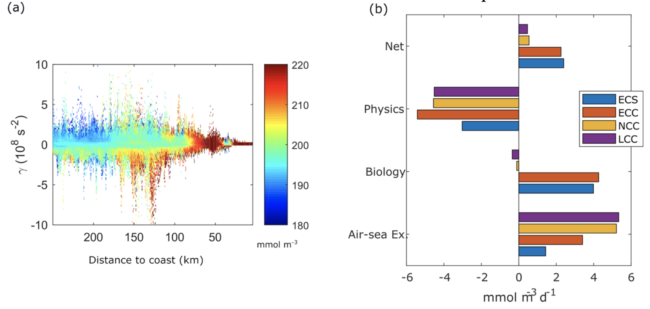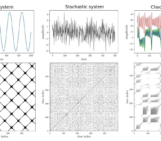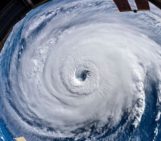
An emerging problem brought by climate change is the on-going deoxygenation of the world’s oceans. The fact that concentrations of dissolved oxygen have been/are declining in both open-ocean and coastal waters is becoming a major scientific and societal concern raised in the Kiel Declaration and in the IUCN (International Union for Conservation of Nature) 2019 report. Lower levels of dissolved oxygen in the ocean can lead to important biogeochemical alterations and habitat compression, causing the redistribution of marine organisms and provoking some massive mortality events. This problem concerns highly productive coastal upwelling regions, which are very sensitive to variations in oxygen concentrations levels and at the same time, account for a major share in world fish catch.
Upwelling regions are being affected by climate change in several ways. One of the most important is the change in the wind regime that controls the upwelling dynamics. Another relevant effect is the modification of phytoplankton communities, which constitute the base of the food chain that sustains higher trophic levels including zooplankton and fish stocks. To find out how these consequences of climate change could affect the oxygen concentrations in the Iberian Peninsula Upwelling System, we performed numerical simulations to study the response of oxygen concentration levels to changes in wind patterns and phytoplankton species.
In coastal upwelling systems, winds blowing equatorward cause surface waters to move offshore, being replaced by colder, nutrient rich deep waters. These nutrient rich waters promote the growth of phytoplankton that supports higher trophic levels. When cold waters reach the surface, a temperature front is formed a few tenths of kilometers off the coast. This front is unstable and wind fluctuations quickly cause the formation of vortices and filaments that can extend hundreds of kilometers offshore. Our study focused on this dynamical environment, where three elements control the oxygen concentrations: the atmosphere, the biological activity and the internal upwelling dynamics. The air-sea oxygen fluxes are determined using the wind speed and the interface oxygen concentrations; the living organisms can produce oxygen through photosynthesis and consume it by respiration; the upwelling dynamics can either bring waters depleted/enriched in oxygen from the subsurface or transport offshore oxygen rich/poor waters through the frontal instabilities (Figure 1a). It is the balance between all these factors that ultimately determines the oxygen concentration levels (Figure 1b).
We developed a coupled physical-biogeochemical model that accounts for all these elements and used it in simulations of an idealized Iberian Peninsula Upwelling System where upwelling winds and phytoplankton growth rate were modified, reflecting observed and predicted changes of these two factors. Our results (Figure 1b) suggest that oxygen levels in the Iberian Peninsula Upwelling would decrease with wind blowing for long periods of time, because the sustained upwelling dynamics would carry oxygen rich waters offshore, or with phytoplankton communities dominated by species growing slowly, since the photosynthetic production would be lower.
As of now, the Iberian Peninsula Upwelling System is relatively well oxygenated, but our results demonstrate that the expected trends in wind regime and phytoplankton community modification may be, if confirmed, damaging for the coastal ecosystem of the Iberian Peninsula and for the socio-economic activities that depend on it.




